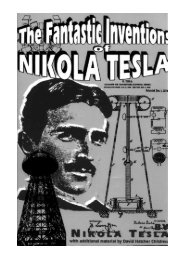the fantastic inventions of nikola tesla - Exopolitics Hong Kong
the fantastic inventions of nikola tesla - Exopolitics Hong Kong
the fantastic inventions of nikola tesla - Exopolitics Hong Kong
Create successful ePaper yourself
Turn your PDF publications into a flip-book with our unique Google optimized e-Paper software.
incandescent gas, a flame photosphere, many hundred times <strong>the</strong> volume <strong>of</strong> <strong>the</strong> electrode. With a diamond,<br />
carborundum or zirconia button <strong>the</strong> photosphere can be as much as one thousand times <strong>the</strong> volume <strong>of</strong> <strong>the</strong> button.<br />
Without much reflecting one would think that in pushing so far <strong>the</strong> incandescence <strong>of</strong> <strong>the</strong> electrode it would be<br />
instantly volatilized. But after a careful consideration he would find that, <strong>the</strong>oretically, it should not occur, and in<br />
this fact—which, however, is experimentally demonstrated—lies principally <strong>the</strong> future value <strong>of</strong> such a lamp.<br />
At first, when <strong>the</strong> bombardment begins, most <strong>of</strong> <strong>the</strong> work is performed on <strong>the</strong> surface <strong>of</strong> <strong>the</strong> button, but when a<br />
highly conducting photosphere is formed <strong>the</strong> button is comparatively relieved. The higher <strong>the</strong> incandescence <strong>of</strong> <strong>the</strong><br />
photosphere <strong>the</strong> more it approaches in conductivity to that <strong>of</strong> <strong>the</strong> electrode, and <strong>the</strong> more, <strong>the</strong>refore, <strong>the</strong> solid and<br />
<strong>the</strong> gas form one conducting body. The consequence is that <strong>the</strong> fur<strong>the</strong>r is forced <strong>the</strong> incandescence <strong>the</strong> more work,<br />
comparatively, is performed on <strong>the</strong> gas, and <strong>the</strong> less on <strong>the</strong> electrode. The formation <strong>of</strong> a powerful photosphere is<br />
consequently <strong>the</strong> very means for protecting <strong>the</strong> electrode, This protection, <strong>of</strong> course, is a relative one, and it should<br />
not be thought that by pushing <strong>the</strong> incandescence higher <strong>the</strong> electrode is actually less deteriorated Still,<br />
<strong>the</strong>oretically, with extreme frequencies, this result must be reached, but probably at a temperature too high for most<br />
<strong>of</strong> <strong>the</strong> refractory bodies known. Given, <strong>the</strong>n, an electrode which can withstand to a very high limit <strong>the</strong> effect <strong>of</strong> <strong>the</strong><br />
bombardment and outward strain, it would be safe no matter how much it is forced beyond that limit. In an<br />
incandescent lamp quite different considerations apply. There <strong>the</strong> gas is not at all concerned: <strong>the</strong> whole <strong>of</strong> <strong>the</strong> work<br />
is performed on <strong>the</strong> filament; and <strong>the</strong> life <strong>of</strong> <strong>the</strong> lamp diminishes so rapidly with <strong>the</strong> increase <strong>of</strong> <strong>the</strong> degree <strong>of</strong><br />
incandescence that economical reasons compel us to work it at a low incandescence. But if an incandescent lamp is<br />
operated with currents <strong>of</strong> very high frequency, <strong>the</strong> action <strong>of</strong> <strong>the</strong> gas cannot be neglected, and <strong>the</strong> rules for <strong>the</strong> most<br />
economical working must be considerably modified.<br />
In order to bring such a lamp with one or two electrodes to a great perfection, it is necessary to employ impulses <strong>of</strong><br />
very high frequency. The high frequency secures, among o<strong>the</strong>rs, two chief advantages, which have a most<br />
important bearing upon <strong>the</strong> economy <strong>of</strong> <strong>the</strong> light production. First, <strong>the</strong> deterioration <strong>of</strong> <strong>the</strong> electrode is reduced by<br />
reason <strong>of</strong> <strong>the</strong> fact that we employ a great many small impacts, instead <strong>of</strong> a few violent ones, which shatter quickly<br />
<strong>the</strong> structure; secondly, <strong>the</strong> formation <strong>of</strong> a large photosphere is facilitated.<br />
In order to reduce <strong>the</strong> deterioration <strong>of</strong> <strong>the</strong> electrode to <strong>the</strong> minimum, it is desirable that <strong>the</strong> vibration be harmonic,<br />
for any suddenness hastens <strong>the</strong> process <strong>of</strong> destruction. An electrode lasts much longer when kept at incandescence<br />
by currents, or impulses, obtained from a high-frequency alternator, which rise and fall more or less harmonically,<br />
than by impulses obtained from a disruptive discharge coil. In <strong>the</strong> latter case <strong>the</strong>re is no doubt that most <strong>of</strong> <strong>the</strong><br />
damage is done by <strong>the</strong> fundamental sudden discharges.<br />
One <strong>of</strong> <strong>the</strong> elements <strong>of</strong> loss in such a lamp is <strong>the</strong> bombardment <strong>of</strong> <strong>the</strong> globe. As <strong>the</strong> potential is very high, <strong>the</strong><br />
molecules are projected with great speed ; <strong>the</strong>y strike <strong>the</strong> glass, and usually excite a strong phosphorescence. The<br />
effect produced is very pretty, but for economical reasons it would be perhaps preferable to prevent, or at least reduce<br />
to <strong>the</strong> minimum, <strong>the</strong> bombardment against <strong>the</strong> globe, as in such case it is, as a rule, not <strong>the</strong> object to excite<br />
phosphorescence, and as some loss <strong>of</strong> energy results from <strong>the</strong> bombardment. This loss in <strong>the</strong> bulb is principally<br />
dependent on <strong>the</strong> potential <strong>of</strong> <strong>the</strong> impulses and on <strong>the</strong> electric density on <strong>the</strong> surface <strong>of</strong> <strong>the</strong> electrode. In employing<br />
very high frequencies <strong>the</strong> loss <strong>of</strong> energy by <strong>the</strong> bombardment is greatly reduced, for, first, <strong>the</strong> potential needed to<br />
perform a given amount <strong>of</strong> work is much smaller; and, secondly, by producing a highly conducting photosphere<br />
around <strong>the</strong> electrode, <strong>the</strong> same result is obtained as though <strong>the</strong> electrode were much larger, which is equivalent to a<br />
smaller electric density. But be it by <strong>the</strong> diminution <strong>of</strong> <strong>the</strong> maximum potential or <strong>of</strong> <strong>the</strong> density, <strong>the</strong> gain is effected<br />
in <strong>the</strong> same manner, namely, by avoiding violent shocks, which strain <strong>the</strong> glass much beyond its limit <strong>of</strong> elasticity.<br />
If <strong>the</strong> frequency could be brought high enough <strong>the</strong> loss due to <strong>the</strong> imperfect elasticity <strong>of</strong> <strong>the</strong> glass would be entirely<br />
negligible. The loss due to bombardment <strong>of</strong> <strong>the</strong> globe may, however, be reduced by using two electrodes instead <strong>of</strong><br />
one. In such case each <strong>of</strong> <strong>the</strong> electrodes may be connected to one <strong>of</strong> <strong>the</strong> terminals; or else, if it is preferable to use<br />
only one wire, one electrode may be connected to one terminal and <strong>the</strong> o<strong>the</strong>r to <strong>the</strong> ground or to an insulated body<br />
<strong>of</strong> some surface, as, for instance, a shade on <strong>the</strong> lamp. In <strong>the</strong> latter case, unless some judgment is used, one <strong>of</strong> <strong>the</strong><br />
electrodes might glow more intensely than <strong>the</strong> o<strong>the</strong>r.<br />
But on <strong>the</strong> whole I find it preferable when using such high frequencies to employ only one electrode and one connecting<br />
wire. I am convinced that <strong>the</strong> illuminating device <strong>of</strong> <strong>the</strong> near future will not require for its operation more<br />
than one lead, and, at any rate, it will have no leading-in wire, since <strong>the</strong> energy required can be as well transmitted<br />
through <strong>the</strong> glass. In experimental bulbs <strong>the</strong> leading-in wire is most generally used on account <strong>of</strong> convenience, as in<br />
employing condenser coatings in <strong>the</strong> manner indicated in Fig. 22, for example, <strong>the</strong>re is some difficulty in fitting <strong>the</strong><br />
parts, but <strong>the</strong>se difficulties would not exist if a great many bulbs were manufactured; o<strong>the</strong>rwise <strong>the</strong> energy can be<br />
conveyed through <strong>the</strong> glass as well as through a wire, and with <strong>the</strong>se high frequencies <strong>the</strong> losses are very small.<br />
Such illuminating devices will necessarily involve <strong>the</strong> use <strong>of</strong> very high potentials, and this, in <strong>the</strong> eyes <strong>of</strong> practical









